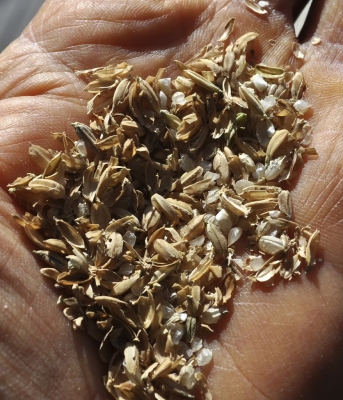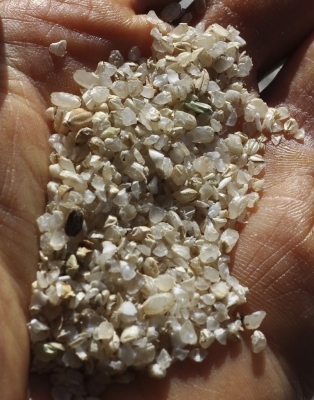THE GOOD OL’ DAYS
Corn Made Even easier
I can understand why corn was so popular a crop early on in the settlement of our country by Europeans. Sure, it tastes good popped, ground and cooked, and, while immature, fresh from the cob. Mostly, though, corn was easy to grow in the rough soil left from recently cleared forest.
Most of my corn grows in my two vegetable gardens where the soil is crumbly and weed-free, watered gently by drip irrigation, and nourished annually with an inch depth of compost.

Highly cultivated sweet corn
The south garden is home, every year, to a couple of beds (about 60 square feet) of popcorn, and the north garden to 4 beds (about 215 square feet) of sweet corn. Those two gardens provide us with all the sweet corn and popcorn we eat for a year.
Separate gardens are needed because if sweet and popcorn cross-pollinate, the sweet corn will be less sweet and the popcorn won’t pop as well.
I also grow polenta corn, an heirloom Italian variety called Otto File. But I only have two vegetable gardens. So this corn goes out in the field into the weedy soil between my dwarf apple trees. Conditions there aren’t as rough as cornfields wrought from forests in colonial times, but out there the corn must deal with weeds, grasses, rabbits, and drink only water that falls from the sky.
I did not use colonial methods to ready the soil for planting. Instead, I mowed all vegetation to the ground, and covered the planting areas, 2 beds each about 3 feet wide for a total of about 100 square feet of planting, with gray resin paper. (Sometimes called building paper, gray resin paper is used in construction, usually as underlayment under flooring and siding.) I topped the paper with an inch or so of compost, then made two rows in each bed, in each row poking holes 2 feet apart into each of which I dropped 6 Otto File seeds followed by a sprinkling of water.
The seedlings are up and looking strong, so I thinned them out to 3 or 4 plants per hole, pulling out a few weeds as I thinned. I’ll weed one or two more times and then leave the plants to themselves. Weeds will grow, but the then-tall corn plants should shade some into submission and hold their own against the more aggressive ones.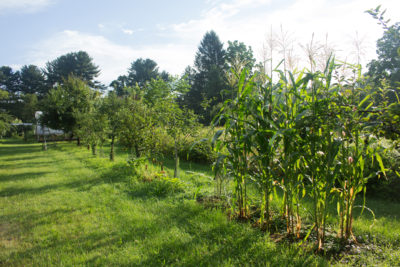
For authenticity, yes, I could have buried some fish in the ground at each planting hole. But that would be more work, and I’m interested in production with minimal effort from that planting. Each year those beds have provided a year’s supply of polenta corn.
Apple Threats
Apple trees flanking the Otto File beds are loaded with a hopeful crop of cherry-sized fruits. The dreaded plum curculio, which is as happy to ruin a crop of apples, peaches, nectarines, or cherries as well as plums, should have ceased their egg-laying by now, and burrowed into the soil to prepare for next year’s onslaught. (Surround® is an organically approved spray of specially formulated kaolin clay that controls curculios.)
Just because the nascent fruits have come along this far does not mean I’m home free. Apple maggot reliably makes its appearance just as the curculios vanish. This pest doesn’t usually make the fruit drop, as do curculios, but it riddles the fruit with so many tunnels that you can’t even eat around them.
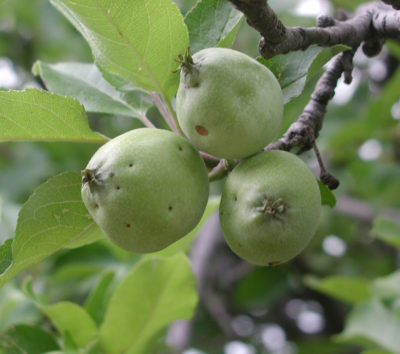
Maggot & curculio scars
Fortunately, non-chemical control of apple maggot is easy. In the 1980s, Dr. Ron Prokopy, at the University of Massachusetts, discovered that Ms. Maggot was attracted to the reddest apples, so he tried hanging croquet balls painted Tartarian Red and coated with forever-sticky Tangletrap® in apple trees. Maggots tried to lay eggs in the ersartz apples, where they expired, their mission unfulfilled. The spheres offer as good control as do chemical sprays.
In the last few years, I’ve used Tangletrap® coated, real Red Delicious apples as traps. They are very red and very apple-like. Hung in the branches, one per dwarf apple tree, they last almost the whole season and, when the season ends, can be composted rather than scraped clean for use the following year.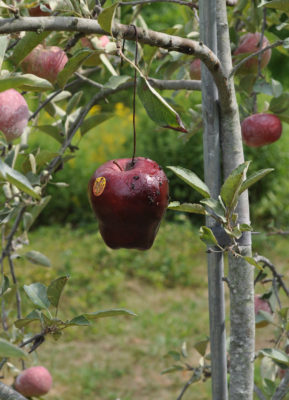
Apple maggot isn’t the only remaining threat to my apples. There’s also the codling moth (the classic worm in the apple), apple scab (that’s what it looks like), and various summer rots.
Once Upon A Time
Oh, for the good ol’ days when the grass was greener, the corn was sweeter, and apple trees took care of themselves. Mostly, the good ol’ days weren’t the various “-ers.” But one exception was the apple maggot. Two hundred years ago, Ms. Maggots didn’t look twice at apples. This native insect was happy to attack our native hawthorns, which are related to apples.
When apples were introduced to this part of the world, some apple maggot flies tried them out. Over time, some began to favor apples over hawthorns, so much so that the maggots evolved into two tribes, one favoring hawthorn and the other apples. Oh well.



